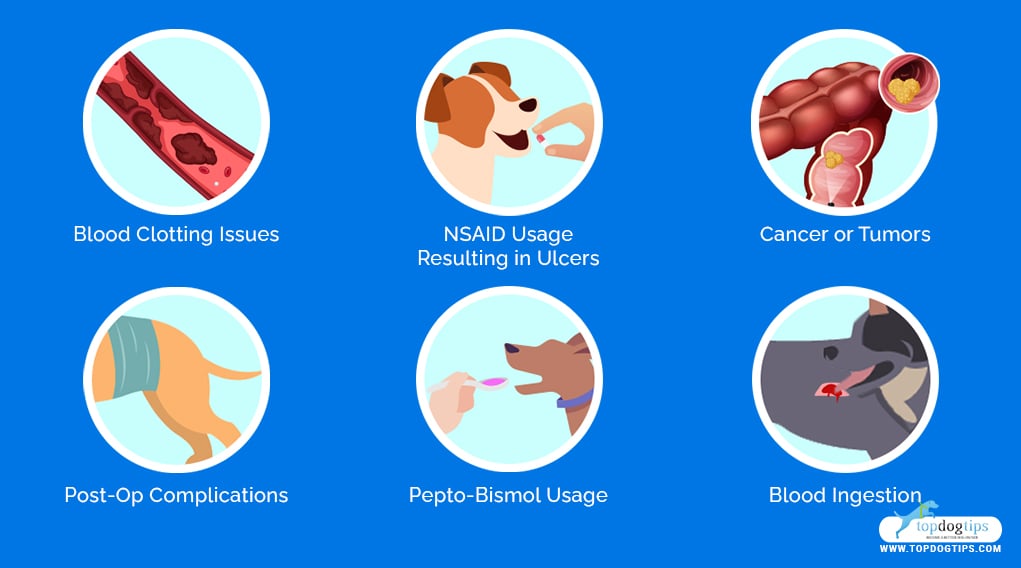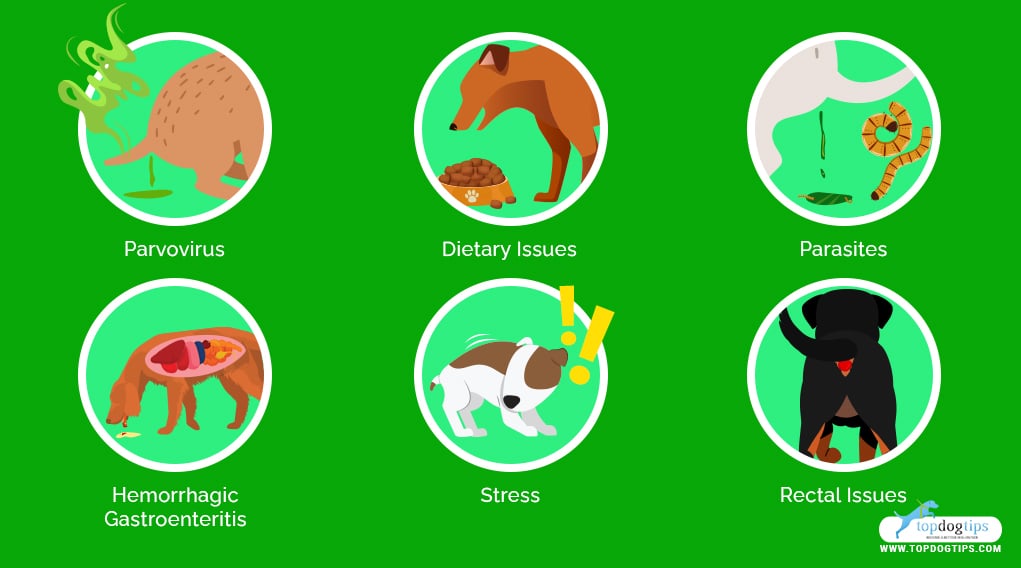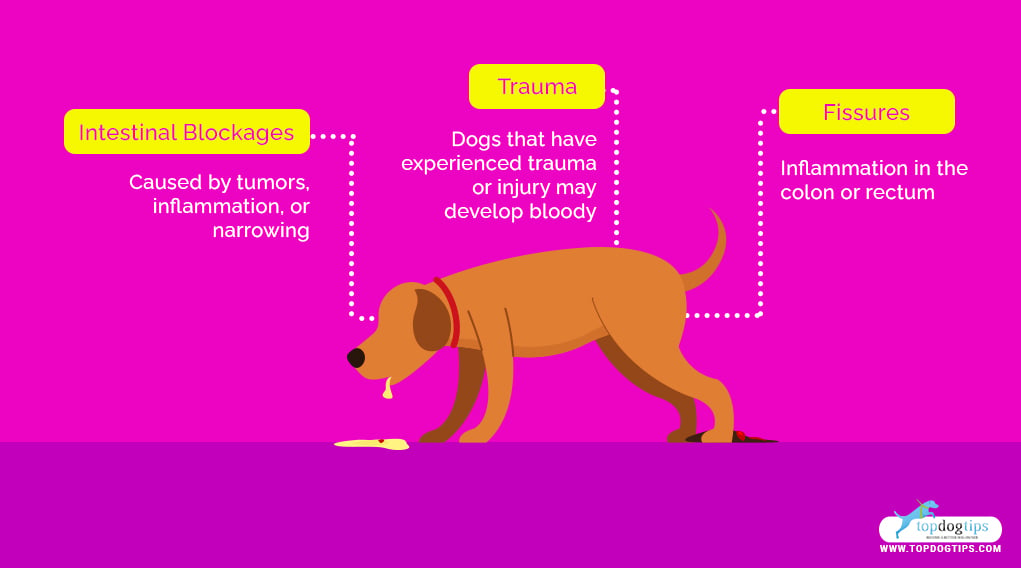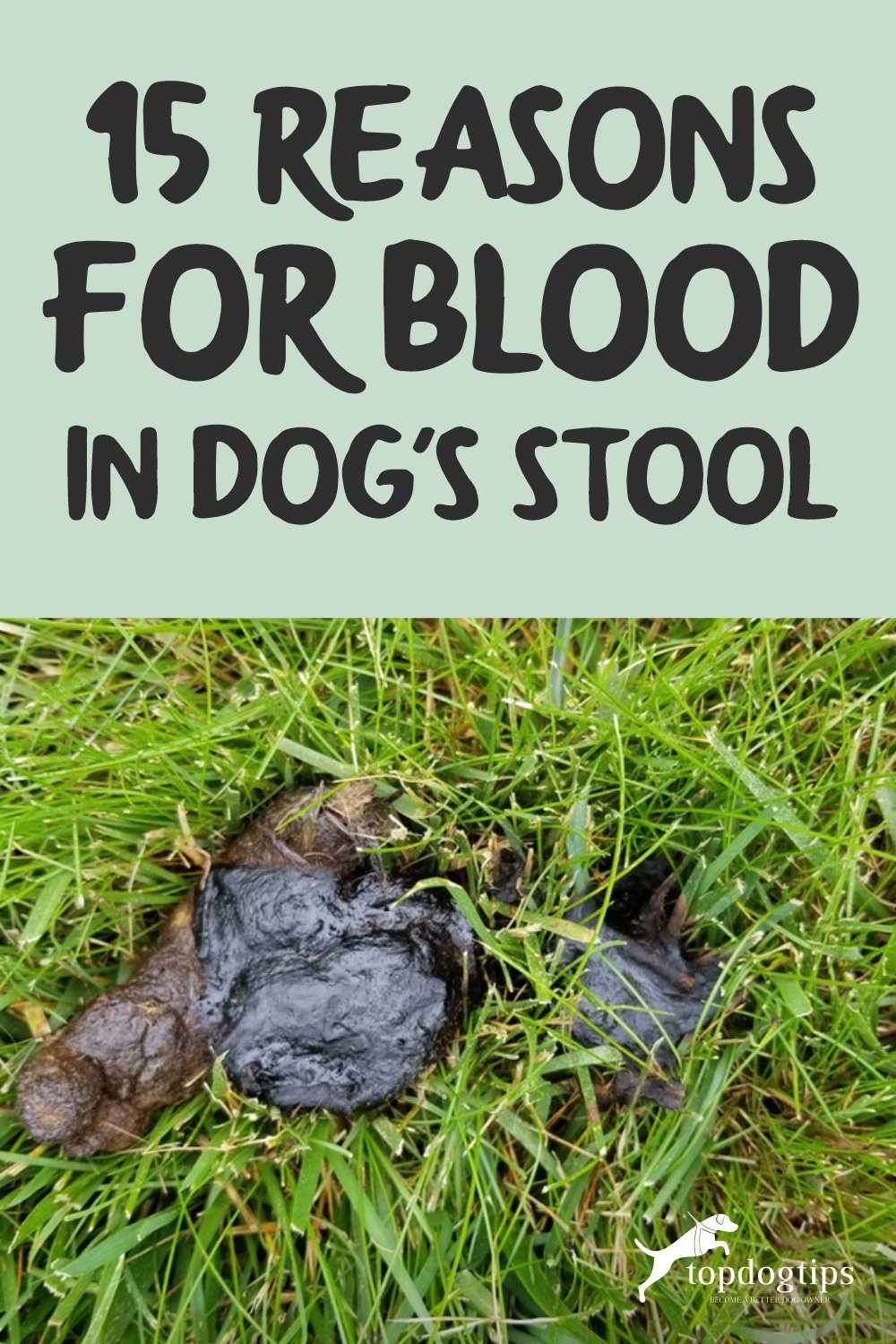If you noticed blood in a dog's stool, there could be several causes. Generally, there are two types of blood present in a dog’s stool – Melena and Hematochezia – and they result from different conditions with different symptoms.
Melena is black or tarry and jelly-like or coffee-ground in appearance. This indicates a problem in the dog's upper gastrointestinal tract (stomach, esophagus, upper small intestine). It may also indicate a problem in the lungs. Melena-blood is darker because it has been digested on its way through the GI tract.
Hematochezia is characterized as being bright red in appearance. This type of bleeding originates in the dog's lower GI, colon, or rectum. This type of blood maybe both in the stool or shed after defecating.
How to Tell If a Dog's Dark Stools Contain Blood?
If you cannot see blood in your dog's feces with a naked eye, you can try a few things:
- Place dog’s stool on a piece of paper towel.
- Check for any abnormalities in the dog's feces (e.g., different shape, consistency, color, size, content).
- Notice if there is a reddish residue defusing from the feces. If so, there is most likely melena present.
- Obvious bright red blood indicates Hematochezia.
6 Reasons for Melena in a Dog’s Stool

Melena (dark blood) in a dog's stool can indicate serious health issues in your pet and should be investigated further by a veterinarian.
Blood Clotting Issues
Along with black tarry stools, a blood clotting disorder can also present symptoms such as purple-tinted skin (an indication of blood under the skin). Ingesting rat poison can cause a dog to bleed internally, as well as some diseases like hemophilia.
NSAID Usage Resulting in Ulcers
NSAIDs (Non-Steroidal Anti-Inflammatory drug) such as Aspirin or Rimadyl are blood thinners, and they may cause bleeding ulcers in your dog’s stomach when used long-term. The stools appear tarry because the blood has been digested before elimination.
Cancer or Tumors
Polyps or bleeding tumors can cause melena in dogs, especially those that are aging or predisposed to certain cancers.
Post-Op Complications
If your dog has recently had surgery and you see tarry stools, call your vet immediately. This can be an indication of internal bleeding. Melena can appear up to 72 hours after surgery.
Pepto-Bismol Usage
One of the side effects of Pepto Bismol in dogs is dark stools. However, this medication can also cause gastric bleeding in dogs after long-term usage. Never use Pepto-Bismol long-term unless under the supervision of a veterinarian.
Blood Ingestion
This could be the result of a mouth injury that causes your pooch to swallow blood or if your dog has licked a gaping wound, which would result in black stools.
6 Reasons for Hematochezia in a Dog’s Stool

Hematochezia (bright blood) in a dog’s stool should also be taken very seriously. One or more of the following issues may be the culprit, but always consult a veterinarian for a full diagnosis.
Parvovirus
This serious condition is often found in puppies and is characterized by foul-smelling bloody diarrhea, accompanied by vomiting, loss of appetite, and lethargy. Parvovirus can be fatal, and suspected cases need veterinary care immediately.
Dietary Issues
Changes in your dog’s diet or other indiscretions like overeating or the ingestion of foreign objects can all cause hematochezia. If you are changing your pet’s food, do it slowly over a week to avoid inflammation of the colon. Allergies, feeding people food, or the ingestion of spoiled food can also produce bright red blood in your dog’s feces.
Parasites
Hookworms, whipworms, and roundworms are the most common reason behind hematochezia in a dog’s feces. Protozoa, such as coccidia, is another internal parasite that may cause blood in the dog’s stool. Bring a fresh sample of feces to the vet to determine if this is the cause.
Hemorrhagic Gastroenteritis
This condition produces large amounts of blood in a dog's stool, along with other symptoms such as vomiting and diarrhea. Often the cause is unknown, but your dog may need intravenous fluids and medications before the issue subsides.
Stress
Dogs that are being held in a shelter, are being boarded, traveling, or have experienced a change in their home-life can develop severe stress, leading to blood in the stool or a chronic condition called colitis.
Rectal Issues
If your dog swallows a sharp object like a stick or a chicken bone, these can scrap the lower intestine or the rectum as it passes through your dog’s system. If you see bits of foreign material in your dog’s stool, the bleeding should stop once the object has fully passed.
If your dog’s feces is well-formed and has bright red blood on the surface, this could be a sign of rectal polyps. These abnormal growths are highly vascularized and will bleed when the stool passes over them. These types of polyps can be both internal and external.
Injuries to the rectum or the anal glands can also cause hematochezia in dogs.
3 Additional Causes of Blood in Dog’s Stool

Intestinal Blockages
If your dog or puppy has eaten something that cannot easily pass, they could develop an intestinal blockage. This type of condition can also be caused by tumors, inflammation, or narrowing. Intestinal blockage can be serious, so contact your vet immediately if you suspect this problem in your dog.
Trauma
Dogs that have experienced trauma or injury may develop bloody stools.
Fissures
Inflammation in the colon or rectum can cause tearing (fissures) when the animal defecates, producing blood in the stool. This condition can be serious and will also need veterinarian attention.
Conclusion
You should always take blood in a dog’s stool seriously. Whether it be melena (dark and tarry color) or hematochezia (bright red color), monitor your dog closely for other symptoms, then get to your veterinarian as soon as possible.
Common Questions about a Dog Pooping Blood
If you still have questions about an unusual dog stool, then continue reading. We've answered the most common questions about a bloody stool and other issues regarding your dog's poop.
What Does it Mean When a Dog Has Blood in their Stool?
If you notice a bloody stool, your dog's poop may be telling you that there is something wrong with him. He may have a viral or bacterial infection, hemorrhagic gastroenteritis, parvovirus, or any of the other issues we mentioned above that may lead to red blood in your dog's stool.
Will Blood in Dog Stool Go Away on Its Own?
If you notice your dog pooping blood, it could potentially go away on its own, but that is not always the case. If you don't notice any other dog's symptoms, then you can wait a day or two to see. If it continues, you should definitely take your dog to the vet to get to the cause of his pooping blood.
What Does Parvo Poop Look Like?
We mentioned parvo as one of the potential issues that can lead to your dog pooping blood. In addition to being bloody, diarrhea from a dog with parvo may have a color between mustard and light yellow. Dog owners should also look for other symptoms of parvo outside of those in the dog poop. For example, expect a dog with parvo to vomit.
Is Red Blood in Stool Serious for Dogs?
If dog owners notice bright red blood in stools, this may or may not be serious. It can be a minor issue that disappears on its own within a day or two. If it continues, your dog's vet will want to check his digestive tract. He may also want to test for blood clotting disorders, inflammatory bowel disease, viral and bacterial infections, or other potential causes. Most vets will ask for a fresh stool sample to help with diagnosis.
Can Dog Food Cause Bloody Diarrhea?
Yes, what your pooch eats can lead to blood in dog stool. This can happen if he eats something unusual or something that isn't technically food. This could inflame or irritate your dog's digestive tract, leading to blood in dog stool. This is one of the reasons dog owners should always be careful about what they feed their pups.
READ NEXT: Dog Poop Color Chart – What It All Means














